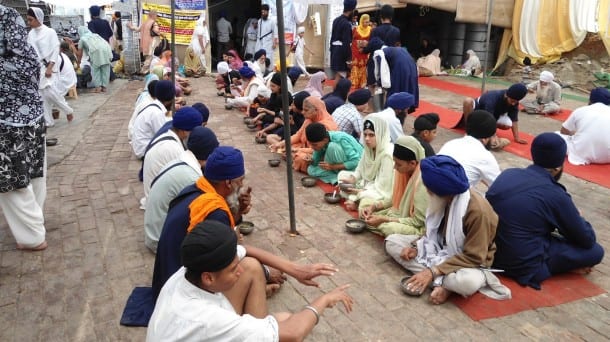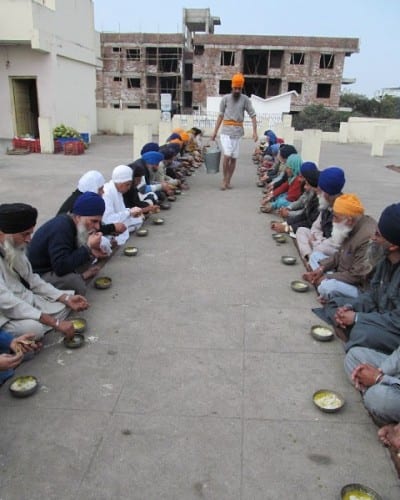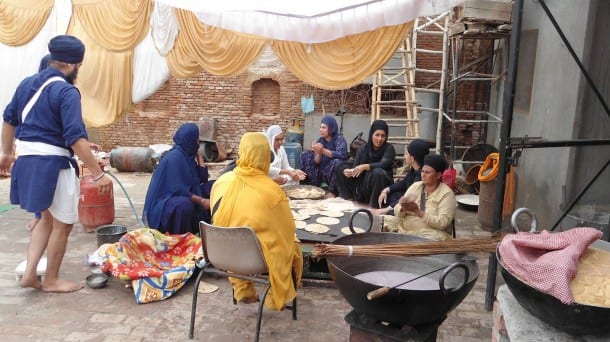The institution of Langar in Sikhism is commonly known as Guru-Ka-Langar which means langar of the Guru, langar in the name of the Guru, or langar attached to Gurdwara.
Langar is Persian word meaning:
- “an alms house”
- “an asylum for the poor and the destitute”
- “a public kitchen kept by a great man for his followers, and dependents, the holy men, and the needy.”
Guru-Ka-Langar conveys more the last meaning, then other meanings as it was “run by the Guru” and is being “run in the name of the Guru.”
Bhai Kahan Singh and Kapur Singh are of the opinion that the word langar is from Sanskrit analgrah, meaning “the cooking place.”
Kapur Singh says Guru-ka-langar was an Aryan institution which was revived by the Sikh Gurus. He writes that this institution was used by the Gurus as powerful lever for equalitarian uplift of the people, by demolishing caste barriers, and that the economic apartheid of Varan-asram-dharma is a pristine Aryan institution, non-Brahmic, but having Vedic sanction. A reference to the Community Kitchen or the Guru-ka-langar occurs in the Artharva Veda, which says, “Identical shall be your drink, in common shall be your share of food.”



In all Persian and Urdu dictionaries langar has been mentioned as a Persian word. Not only the word langar as it is, but also the institution of langar can be traced in Persian literature. The langar of the Sufi saints were very common in the 12th and 13th centuries; and still some “Langars of the Sufis” are renown for their feasts and generosity, like the langar at the tomb of Khawaja Muin-ud-din Chisti, at Ajmer.
The Sikh gurdwaras are not only places of worship, but also the training center of service. Such services as sweeping the precincts, serving drinking water to the thirsty, fanning the congregation in hot weather, and serving food to the hungry, have always formed an integral part of the functions in a Sikh shrine. Of these, langar is perhaps the most important. A Sikh gurdwara without a free kitchen is inconceivable.
In its very inception, as a protest against the inequities of the caste system, the Sikh langar is a “common refectory” attached to every gurdwara. Guru Nanak had started a crusade against the tyrannies of the high born over the people of humble origin; and the Guru’s langar was an institution which was promulgated in this holy campaign. A practical step to root out the evil which was eating into the very vitals of the Indian people, the free kitchen became the foundation of equality and fraternity, among the followers of the Guru.
If one studies aright the ideals of Sikhism, one would be simply impressed by a really unique feature: the secularization of service. And this ideal is most vividly practiced in the Guru’s free kitchen, which is open to all. Those who profess other faiths are as freely allowed to partake of, and help in the running of, the kitchen as the followers of the Sikh faith themselves. No distinction is made between man and woman, between the Sikhs, and the non-Sikhs, between the high caste, and the low caste, in the seating, or serving of food in the Guru’s kitchen.
“Men of God, wherever they are, of whatever race or creed, belong to one community, the community of man, free from the chains of birth, creed and race.”



The Sikh Gurus exhorted their followers to regard everyone as their own brother. We are brothers born of the same father. “Our Father is one and we are all his children.” We are members of one family. All the Gurus showed in actual life how this precept of the “Brotherhood of Man” was to be lived out. The free kitchen is perhaps the best demonstration of the same love and active sympathy for the downtrodden, to lift and hug the fallen, and to share our earnings with the needy and the poor, are some of the factors of a true religion. And the free kitchen is an institution where these noble ideals can be practiced.
A Sikh gurdwara is a central place of worship, and langar is a place for serving each other. In a langar, a mingling of all classes is provided, and in dining together comes the realization of the truth “all food is gift of God and that prejudices about it are entirely invalid.” A Sikh repeats these words every day in his prayer:
“Utter WaheGuru and meditate on the deeds of those who worshiped the Name, and shared their food with others.”
“Bread and water belong to the Lord , and the desire to serve, is the pleasure of Sikhs,” is the common utterance of the Guru’s disciples when serving in the free kitchen. Langar, in short, helps in teaching service, spreading equality, removing untouchable stigma, and such other evils and prejudices as spring from social and racial distinctions. The institution of langar is as old as Sikhism. It was started by Guru Nanak and carried on by his successors. Guru Nanak declared that every Sikh-house should be Sach-Dharmsal (a place of open hearted charity, truth and devotion).
In the words of Bhai Gurdas, “Wherever the holy feet of Guru Nanak touched, Dharamsals were erected,” which were at once the houses of charity as well as devotion. In a way the kitchen in every Sikh’s house is a Guru-ka-langar, as he is enjoined to share his food with others.
Puran Singh rightly observes, “Today no Sikh with a grain of faith in him, can possibly think that he owns the bread.” Langar at a Sikh gurdwara is the community kitchen. Every Sikh is expected to take part in the running of the kitchen. He may pay for the expenses, bring provisions, or personally contribute the labor of love, by cleaning utensils, fetching water, or fuel, or taking a hand in cooking and distributing food. Puran Singh calls Guru’s langar “Temple of Bread” and says, “What is a home, but a hospitable feasting of children with bread and love and faith? What is spiritual life in the temple of flesh, without a full meal first? The very first temple made by Guru Nanak, therefore, was the Temple of Bread, or Guru’s Langar. In one common Temple of Bread, the bread of God was made free to the children of man. Let none be hungry where the spirit of God prevails. The Guru’s people, and the Guru, were one home and one family, but it was no utopian idea, as of the modern socialism or the democracy of labor, it was the democracy of soul, so gloriously invoked in the temple of the human heart by the genius of the Guru.”






